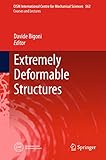Extremely Deformable Structures [electronic resource] / edited by Davide Bigoni.
Contributor(s): Bigoni, Davide [editor.] | SpringerLink (Online service).
Material type: BookSeries: CISM International Centre for Mechanical Sciences: 562Publisher: Vienna : Springer Vienna : Imprint: Springer, 2015Edition: 1.Description: VII, 297 p. 178 illus. online resource.Content type: text Media type: computer Carrier type: online resourceISBN: 9783709118771.Subject(s): Engineering | Structural mechanics | Engineering design | Engineering | Structural Mechanics | Engineering DesignAdditional physical formats: Printed edition:: No titleDDC classification: 620.1 Online resources: Click here to access online
BookSeries: CISM International Centre for Mechanical Sciences: 562Publisher: Vienna : Springer Vienna : Imprint: Springer, 2015Edition: 1.Description: VII, 297 p. 178 illus. online resource.Content type: text Media type: computer Carrier type: online resourceISBN: 9783709118771.Subject(s): Engineering | Structural mechanics | Engineering design | Engineering | Structural Mechanics | Engineering DesignAdditional physical formats: Printed edition:: No titleDDC classification: 620.1 Online resources: Click here to access online New instability phenomena in elastic structures -- Solutions for slender rods in extreme conditions -- Periodic structures, instabilities, wave propagation -- Extremely deformable structures in bio-mechanics -- Bifurcations and path following for nonlinear elastic rods and solids -- Folding an deployment of thin-shell structures.
Recently, a new research stimulus has derived from the observation that soft structures, such as biological systems, but also rubber and gel, may work in a post critical regime, where elastic elements are subject to extreme deformations, though still exhibiting excellent mechanical performances. This is the realm of 'extreme mechanics', to which this book is addressed. The possibility of exploiting highly deformable structures opens new and unexpected technological possibilities. In particular, the challenge is the design of deformable and bi-stable mechanisms which can reach superior mechanical performances and can have a strong impact on several high-tech applications, including stretchable electronics, nanotube serpentines, deployable structures for aerospace engineering, cable deployment in the ocean, but also sensors and flexible actuators and vibration absorbers. Readers are introduced to a variety of interrelated topics involving the mechanics of extremely deformable structures, with emphasis on bifurcation, instability and nonlinear behavior, both in the quasi-static and dynamic regimes. Essential and up-to-date theoretical, numerical, and experimental methodologies are covered, as a tool to progress towards a satisfactory modeling of the nonlinear behavior of structures.


There are no comments for this item.